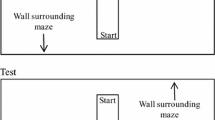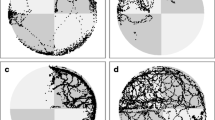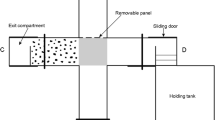Abstract
When animals associate a stimulus with food, they may either direct their response towards the stimulus (sign-tracking) or towards the food (goal-tracking). The direction of the conditioned response of cod was investigated to elucidate how cod read cue signals. Groups of cod were conditioned to associate a blinking light (conditioned stimulus, CS) with a food reward (unconditioned stimulus, US), with the CS and the US located at opposite sides of the tank. Two groups were trained in a delay conditioning procedure (CS = 60 s, interstimulus interval = 30 s) and two groups were trained in a trace conditioning procedure (CS = 12 s, trace interval = 20 s). The response pattern was similar for the delay- and trace-conditioned groups. The initial main response at the onset of the CS was approaching the blinking lights, i.e. sign-tracking. In the early trials, the fish did not gather in the feeding area before the arrival of food. In the later trials, the fish first approached the blinking lights, but then moved across the tank and gathered below the feeder before the food arrived, i.e. sign-tracking followed by goal-tracking within each trial. These two responses are interpreted as reflecting two learning systems, i.e. one rapid, reflexive response directed at the signal (sign-tracking) and one slower, more flexible response based on expectations about time and place for arrival of the food (goal-tracking). The ecological significance of these two learning systems in cod is discussed.




Similar content being viewed by others
References
Anderson JL, Laurel BJ, Brown JA (2007) Diel changes in behaviour and habitat use by age-0 Atlantic cod (Gadus morhua L.) in the laboratory and field. J Exp Mar Biol Ecol 351:267–275. doi:10.1016/j.jembe.2007.07.001
Boakes RA (1977) Performance on learning to associate a stimulus with positive reinforcement. In: Davis H, Hurwitz HM (eds) Operant-Pavlovian interactions. Erlbaum, Hillsdale, pp 67–97
Broglio C, Gomez A, Duran E, Ocana FM, Jimenez-Moya F, Rodriguez F, Salas C (2005) Hallmarks of a common forebrain vertebrate plan: specialized pallial areas for spatial, temporal and emotional memory in actinopterygian fish. Brain Res Bull 66:277–281. doi:10.1016/j.brainresbull.2005.03.021
Brown BL, Hemmes NS, Devaca SC, Pagano C (1993) Sign and goal tracking during delay and trace autoshaping in pigeons. Anim Learn Behav 21:360–368
Brown PL, Jenkins HM (1968) Auto-shaping of pigeon’s key-peck. J Exp Anal Behav 11:1–8. doi:10.1901/jeab.1968.11-1
Brown C, Laland KN (2002) Social learning of a novel avoidance task in the guppy: conformity and social release. Anim Behav 64:41–47. doi:10.1006/anbe.2002.3021
Brown C, Laland KN, Krause J (2006) Fish cognition and behavior. Blackwell, Oxford
Bull HO (1928) Studies on conditioned responses in fishes. J Mar Biol Assoc UK 15:485–533
Burns M, Domjan M (1996) Sign tracking versus goal tracking in the sexual conditioning of male Japanese quail (Coturnix japonica). J Exp Psychol Anim Behav Process 22:297–306
Clark RE, Manns JR, Squire LR (2002) Classical conditioning, awareness, and brain systems. Trends Cogn Sci 6:524–531. doi:10.1016/S1364-6613(02) 02041-7
Cole PD, Adamo SA (2005) Cuttlefish (Sepia officinalis: Cephalopoda) hunting behavior and associative learning. Anim Cogn 8:27–30. doi:10.1007/s10071-004-0228-9
Dahle G, Jørstad KE, Rusaas HE, Otterå H (2006) Genetic characteristics of broodstock collected from four Norwegian coastal cod (Gadus morhua) populations. ICES J Mar Sci 63:209–215. doi:10.1016/j.icesjms.2005.10.015
Eichenbaum H, Otto T, Cohen NJ (1992) The hippocampus—what does it do? Behav Neural Biol 57:2–36. doi:10.1016/0163-1047(92) 90724-I
Fjøsne K, Gjøsæter J (1996) Dietary composition and the potential of food competition between 0-group cod (Gadus morhua L) and some other fish species in the littoral zone. ICES J Mar Sci 53:757–770. doi:10.1006/jmsc.1996.0097
Flagel SB, Watson SJ, Robinson TE, Akil H (2007) Individual differences in the propensity to approach signals vs goals promote different adaptations in the dopamine system of rats. Psychopharmacology 191:599–607. doi:10.1007/s00213-006-0535-8
Hanson JM, Chouinard GA (2002) Diet of Atlantic cod in the southern Gulf of St Lawrence as an index of ecosystem change, 1959–2000. J Fish Biol 60:902–922. doi:10.1111/j.1095-8649.2002.tb02417.x
Hearst E, Jenkins HM (1974) Sign-tracking: the stimulus-reinforcer relation and directed actions. Psychonomic Society, Austin
Holland PC (1980) CS-US interval as a determinant of the form of Pavlovian appetitive conditioned-responses. J Exp Psychol Anim Behav Process 6:155–174
Hollis KL (1982) Pavlovian conditioning of signal-centered action patterns and autonomic behavior—a biological analysis of function. Adv Stud Behav 12:1–64
Jenkins HM, Moore BR (1973) Form of auto-shaped response with food or water reinforcers. J Exp Anal Behav 20:163–181. doi:10.1901/jeab.1973.20-163
Laland KN, Williams K (1998) Social transmission of maladaptive information in the guppy. Behav Ecol 9:493–499
Lieberman DA (2000) Learning: behavior and cognition. Wadsworth, Belmont
McCullagh P, Nelder JA (1989) Generalized linear models. Chapman & Hall, London
Methven DA, Schnieder DC, Rose GA (2003) Spatial pattern and patchiness during ontogeny: post-settled Gadus morhua from coastal Newfoundland. ICES J Mar Sci 60:38–51. doi:10.1006/jmsc.2002.1315
Myers RH, Montgomery DC, Vining GG (2002) Generalized linear models: with applications in engineering and the sciences. John Wiley & Sons, New York
Nilsson J, Kristiansen TS, Fosseidengen JE, Fernö A, van den Bos R (2008) Learning in cod (Gadus morhua): long trace interval retention. Anim Cogn 11:215–222. doi:10.1007/s10071-007-0103-6
Nordeide JT, Fosså JH (1992) Diet overlap between 2 subsequent year-classes of juvenile coastal cod (Gadus morhua) and wild and reared cod. Sarsia 77:111–117
Overmier J, Hollis K (1990) Fish in the think tank: learning, memory, and integrated behavior. In: Kesner R, Olton D (eds) Neurobiology of comparative cognition. Lawrence Erlbaum, Hillsdale, pp 205–236
Pavlov IP (1927) Conditioned reflexes. Oxford University Press, Oxford
Peden BF, Browne MP, Hearst E (1977) Persistent approached to a signal for food despite food omission for approaching. J Exp Psychol Anim Behav Process 3:377–399
Peterson GB, Frommer GP, Ackil JE, Hearst ES (1972) Conditioned approach and contact behavior toward signals for food or brain-stimulation reinforcement. Science 177:1009–1011. doi:10.1126/science.177.4053.1009
Pitcher TJ, Parrish JK (1993) Functions of shoaling behaviour in teleosts. In: Pitcher TJ (ed) Behaviour of teleost fishes. Chapman & Hall, London, pp 363–439
Purdy JE, Roberts AC, Garcia CA (1999) Sign tracking in cuttlefish (Sepia officinalis). J Comp Psychol 113:443–449
Ross LG, Ross B (1999) Anaesthetic and sedative techniques for aquatic animals. Blackwell, London
Silva FJ, Silva KM, Pear JJ (1992) Sign-tracking versus goal-tracking—effects of conditioned-stimulus-to-unconditioned-stimulus distance. J Exp Anal Behav 57:17–31. doi:10.1901/jeab.1992.57-17
Squire LR (1992) Memory and the hippocampus: a synthesis from findings with rats, monkeys, and humans. Psychol Rev 99:195–231
Steingrund P, Fernö A (1997) Feeding behaviour of reared and wild cod and the effect of learning: two strategics of feeding on the two-spotted goby. J Fish Biol 51:334–348. doi:10.1111/j.1095-8649.1997.tb01670.x
Toates F (1995) Cognition and evolution—an organization of action perspective. Behav Process 35:239–250. doi:10.1016/0376-6357(95)00058-5
Toates F (1998) The interaction of cognitive and stimulus-response processes in the control of behaviour. Neurosci Biobehav Rev 22:59–83. doi:10.1016/S0149-7634(97)00022-5
Toates F (2006) A model of the hierarchy of behaviour, cognition, and consciousness. Conscious Cogn 15:75–118. doi:10.1016/j.concog.2005.04.008
Waxman HM, McCleave JD (1978) Auto-shaping in archer fish (Toxotes chatareus). Behav Biol 22:541–544. doi:10.1016/S0091-6773(78) 92727-X
Woodard WT, Bitterman ME (1974) Autoshaping in the goldfish. Behav Res Meth Instr 6:409–410
Acknowledgments
We thank Victoria Braithwaite and three anonymous referees for their comments on earlier versions of the manuscript, and Einar Heegaard for advices on the statistical analysis. This study was funded by the Research Council of Norway, and complies with Norwegian regulations on animal experimentation.
Author information
Authors and Affiliations
Corresponding author
Rights and permissions
About this article
Cite this article
Nilsson, J., Kristiansen, T.S., Fosseidengen, J.E. et al. Sign- and goal-tracking in Atlantic cod (Gadus morhua). Anim Cogn 11, 651–659 (2008). https://doi.org/10.1007/s10071-008-0155-2
Received:
Revised:
Accepted:
Published:
Issue Date:
DOI: https://doi.org/10.1007/s10071-008-0155-2




